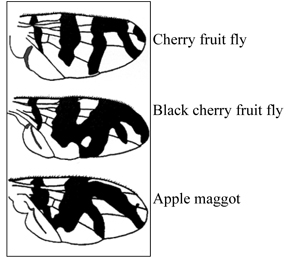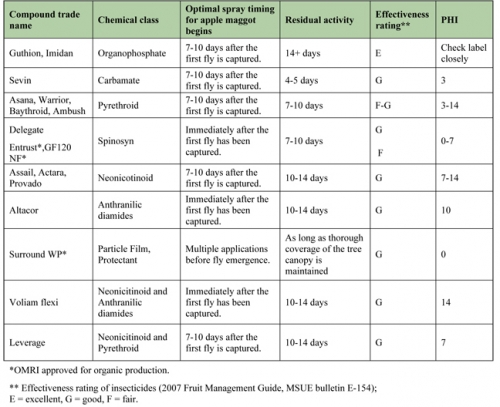Monitoring and management strategies for cherry fruit fly in 2009
Editor’s note: This article is from the archives of the MSU Crop Advisory Team Alerts. Check the label of any pesticide referenced to ensure your use is included.
Cherry fruit fly overwinter as pupae and are developmentally ready to emerge as adults in late spring. Adult fly emergence depends on soil heat accumulation. Peak emergence is highly dependent on site-specific weather conditions. Much of the Michigan fruit growing region has had above normal precipitation and relatively low temperatures over the growing season, so cherry fruit fly emergence is proceeding slower than normal this year.
Monitoring adult cherry fruit fly flight is the key to effective management of this pest. Adult activity can be monitored using yellow sticky boards with ammonium bait. The yellow trap is most useful during the pre-oviposition period when newly emerged females are actively feeding. Traps should be placed on the south-facing side of the top of the canopy of trees in perimeter rows because most flies are expected to be immigrating from wild hosts outside the orchard. The native host of cherry fruit fly is wild black cherry. Optimally, traps should be checked twice weekly until the first fly is captured, then once a week thereafter until the end of the flight.
Identifying cherry fruit fly generally requires the use of a 10X hand lens. Adults are gray flies, approximately 5 mm in length. The most characteristic feature of the fly is the dark pattern on their wings with a broken band at the tip (Figure 1). These wing-banding patterns are used to differentiate between fruit fly species.
The greater the number of traps deployed per block, the greater the confidence level in basing treatment decisions on fly catch. Place at least two traps along borders that historically have been a source of infestation. Proper trap maintenance is crucial to trap effectiveness. Over time, the adhesive can be fouled by leaves, twigs, other insects and debris. Remove debris and insects each time traps are checked. The adhesive should then be evenly redistributed. In determining control treatment timing, on-farm fly catches should be used in conjunction with regional trapping information. Basing treatment decisions solely on regional information may lead to unnecessary insecticide applications. If you employ a good trapping program, a control treatment for CFF is not warranted until flies are captured on your farm. If flies are trapped on-farm, and a regional trap catch was recorded prior to the on-farm fruit fly capture, the treatment should be timed based on the earlier regional capture. This conservative approach is the best way to ensure that the control is applied prior to the flies reaching reproductive maturity and beginning to lay eggs. Chemical control of CFF is focused almost entirely on the adult, with the goal of preventing egg-laying.
Upon emergence, there is a 10 to 12 day period before female flies begin to lay eggs. During this time they are searching for nutritional sources needed to become sexually mature. After female flies complete this pre-oviposition period and have mated, they will seek out fruit for egg-laying. They lay eggs just under the skin of ripening fruit with a needle-like ovipositor, making visual detection of the puncture wound difficult to distinguish from lenticels on the apple surface. Fly larvae, called maggots, hatch from eggs within a week and begin to feed in the flesh of the fruit. Mature maggots drop out of fruit and enter the ground, where they pupate, starting the next generation’s life cycle.
Control of the cherry fruit fly has been traditionally achieved with organophosphate insecticides, like Guthion and Imidan (phytotoxic on sweet cherries), but some label or processor restrictions may limit their use near harvest. Carbamate and synthetic pyrethroid compounds like Sevin and Asana are also toxic to adult fruit flies, but are generally viewed to be moderately effective because they have a shorter field residual. There are several new reduced-risk and OP-replacement insecticide products that include cherry fruit fly on their labels. The neonicotinoids Actara, Provado and Assail are labeled for cherry fruit fly control. All three have performed well against cherry fruit flies in small plot field-performance trials. The Spinosyn compounds Delegate and Entrust are active on cherry fruit flies, but their need for ingestion by adult flies requires excellent spray coverage.
GF120 NF Fruit Fly Bait (spinosad) is registered on pome fruits for control of cherry fruit flies and is listed by the Organic Materials Review Institute (OMRI) for use in organic production. Because the primary route of entry is through ingestion, applying this product during the fruit fly pre-oviposition period is important for optimal performance. GF120 must be applied with specialized equipment, and is designed for low-volume application. The bait is not rainfast and should be re-applied after rain or heavy dew. Field efficacy data is encouraging, but we have limited experience with this novel tool to date.
The pre-mix insecticides Voliam flexi and Leverage are also labeled for cherry fruit fly control. Voliam flexi combines the two active ingredients, thiamethoxam and chlorantraniliprole, as a pre-mix formulated compound. Leverage combines the two active ingredients, imidacloprid and cyfluthrin, as a pre-mix formulated compound. Both have a rating of “good” for cherry fruit fly control in the 2009 Michigan Fruit Management Guide.
The use of SURROUND WP for fruit fly control is based on creating a protective barrier between the plant and the pest that 1) reduces host recognition of the pest, and 2) prevents adult oviposition (egg-laying). Because it is not toxic to adult flies like conventional contact poisons, complete coverage of the plant is critical. Multiple applications are typically needed to attain initial coverage; further sprays may be necessary to respond to wash-off from rain or excessive wind. Field trials indicate that when adequate coverage is maintained, excellent fruit protection can be achieved.
As a final management note, having fly populations infesting fruit that remain on the tree after harvest may be problematic because resident populations represent a source of infestation the following year. Growers with known high fly captures or fruit infestation post-harvest should consider applying an insecticide at this time to combat the resident populations and maintain them at such a low level that the threat of infestation prior to harvest is negligible. Our initial work on post-harvest cherry fruit fly treatments has indicated that the critical time to apply an insecticide is within the first week after harvest.



 Print
Print Email
Email





